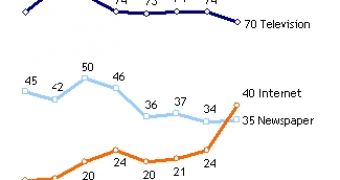In about a year, the Internet has overtaken newspapers as the second most important news sources in the US, both regarding national and international news, a recent poll conducted by the Pew Research Center in December shows. Approximately 40 percent of the interviewed participants said that they used the Internet, whereas only 35 percent still bought papers for up-to-date news and reports. The Internet registered a very steep ascent from last September, when it was resorted to for news information by just 24 percent of the population.
Its growth prospects look even better, if you consider the fact that among young people, aged 30 and below, the Internet actually rivals television as the main source of information. Some 59 percent of the participants to the survey said that they used the Web for reading news, a percentage identical to that of those who stated that TV was still the best information outlet. To put things into perspective, in Sept. 2007 the TV-Internet ratio was 68% to 34%.
Televisions still lead in the eyes of the American public, with 70 percent of people turning to them for their daily dose of news. Experts say that, although the Internet will probably catch on quick, it will never be able to fully replace the iconic TV set as a source of information. The most viewed stations are still CNN (at about 23%), and Fox News (at about 17%), with many other news outlets lagging behind significantly.
News publications have been the traditional medium for spreading information for centuries on end, when the printed press was the only way to spread the word around the country, or throughout the world. Special reports made it on their first pages and everyone wanted to read them. Aggressive street commercials with loud-voice advertising gave birth to the “morning paper” idea.
However, with the introduction of the television, all that quickly changed, as it became more comfortable and time-saving to watch a compact daily news bulletin than to chase the papers' special editions all around the town. With the ease of access that the Internet provides nowadays, people who can go on-line seldom buy papers, mostly because they take a lot of time to read.

 14 DAY TRIAL //
14 DAY TRIAL //